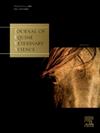母马择期剖宫产时脐带血管灌注处理胎膜残留。
IF 1.6
3区 农林科学
Q2 VETERINARY SCIENCES
引用次数: 0
摘要
剖宫产(c -剖宫产)是母马保留胎膜(RFM)的潜在危险因素,需要及时诊断和治疗以提高预后。本研究旨在评估脐带血管输注治疗母马择期剖腹产后RFM的应用。每天监测10匹怀孕315天的克里奥罗型母马,并在准备分娩时进行选择性剖腹产。所有的母马都表现出RFM,胎盘保留超过三小时,小心地通过剖腹产提取马驹。随机分为两组:脐管输注组(n=5):脐管输注0.9%低压生理盐水;或配重(n=5):包括附着在暴露的胎膜上的轻配重(1kg)。从开始治疗到胎膜完全分离和排出40分钟的母马被归类为对治疗有反应。母马年龄(8±2,3 ~ 20岁)、妊娠期(333±3,328 ~ 360 d)、马驹体重(38±2,30 ~ 50 Kg)、剖宫产手术时间(124±5,90 ~ 150 min)、剖宫产术中操作子宫时间(57±3,45 ~ 70 min)组间差异无统计学意义。结果显示,脐管输注组80% (n=4/5)的母马在40分钟内出现排膜现象,而配重组没有(0%,n=0/5)的母马在40分钟内出现排膜现象(P < 0.05)。接受脐带血管输注方法的母马在手术后没有出现严重的不适、疼痛或其他次要副作用的迹象。综上所述,脐带血管灌注是一种有效、安全、实用的治疗母马剖宫产后胎膜残留的方法。本文章由计算机程序翻译,如有差异,请以英文原文为准。
Management of retained fetal membranes by umbilical vessel infusion in mares submitted to elective C-section
The cesarian section (C-section) is a potential risk factor for retained fetal membranes (RFM) in mares, requiring prompt diagnosis and treatment to enhance outcomes. This study aimed to evaluate the use of umbilical vessel infusion for the treatment of RFM after elective C-section in mares. Ten pregnant criollo type-mares at 315 days of gestation were monitored daily and underwent elective C-section upon readiness for birth. All mares exhibited RFM, with placentas retained beyond three hours careful extraction of the foal by C-section. Those were randomly assigned into two groups: Umbilical vessel infusion (n = 5): using of low-pressure 0.9 % saline solution infusion into the umbilical vessel; or Counterweight (n = 5): involving a light counterweight (1 kg) attached to the exposed fetal membrane. Mares that presented time from onset treatment to full separation and expulsion of the fetal membrane by 40 min were classified as responsive to treatment. There were no differences in mares’ age (8 ± 2, 3-20 years), gestational length (333 ± 3, 328-360 d), foal weight (38 ± 2, 30-50 Kg), the surgical time to C-section (124 ± 5, 90-150 min), and time of uterine manipulation during C-section (57 ± 3, 45-70 min) between groups. Results showed that 80 % (n = 4/5) of mares in the Umbilical Vessel Infusion group achieved membrane expulsion within 40 minutes, while none (0 %, n = 0/5) in the Counterweight group responded within this timeframe (P < 0.05). Mares receiving the umbilical vessel infusion method have not experienced severe signs of discomfort, pain, or additional secondary side effects after the procedure. In conclusion, umbilical vessel infusion is an effective, safe, and practical method for the treatment of retained fetal membranes after C-section in mares.
求助全文
通过发布文献求助,成功后即可免费获取论文全文。
去求助
来源期刊

Journal of Equine Veterinary Science
农林科学-兽医学
CiteScore
2.70
自引率
7.70%
发文量
249
审稿时长
77 days
期刊介绍:
Journal of Equine Veterinary Science (JEVS) is an international publication designed for the practicing equine veterinarian, equine researcher, and other equine health care specialist. Published monthly, each issue of JEVS includes original research, reviews, case reports, short communications, and clinical techniques from leaders in the equine veterinary field, covering such topics as laminitis, reproduction, infectious disease, parasitology, behavior, podology, internal medicine, surgery and nutrition.
 求助内容:
求助内容: 应助结果提醒方式:
应助结果提醒方式:


